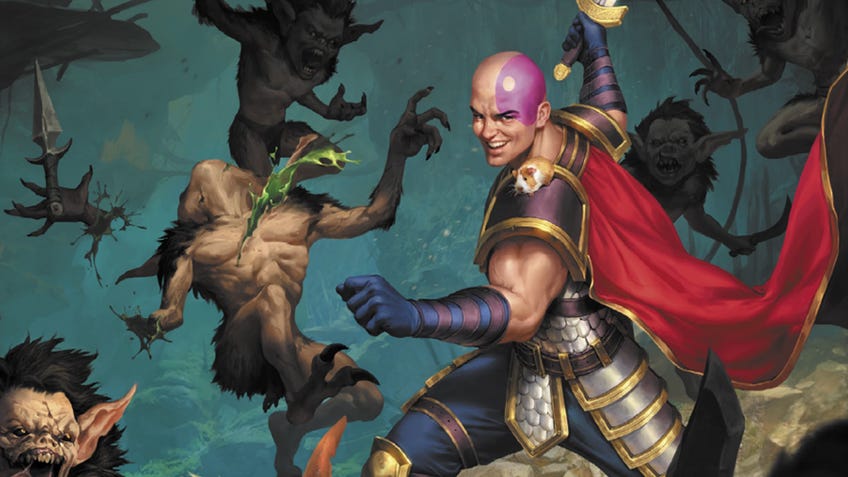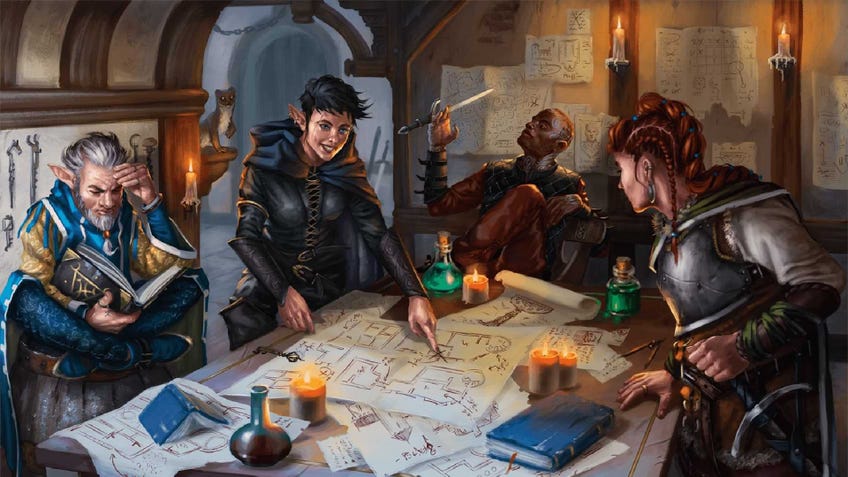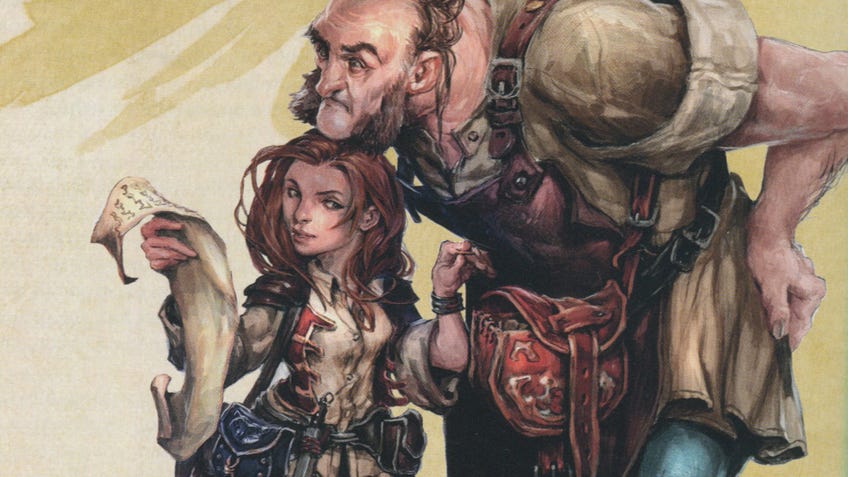D&D size chart and guide for 5E
When size does matter.
The world of Dungeons & Dragons contains people and creatures of all sorts of sizes. From the tiny gnome to the medium minotaur, there are beings that stand both tall and short found all across the various universes of the tabletop roleplaying game.
Besides the obvious appearance element of the different D&D sizes in 5E , there are many ways that size can affect how characters interact with the world and other beings of Dungeons & Dragons. Larger beings will have some advantages that smaller beings won’t have, and vice versa – which of them you prefer will entirely depend on what your priorities are when it comes to combat, traversal and practicality.
D&D 5E sizes explained
- What is character size in D&D 5E?
- What are the different D&D character sizes in 5E?
- Does character size matter in D&D?
- D&D 5E size rules
- Does size affect what armour you can wear?
- Does size affect what weapon you can wield?
- Which is the best character size in D&D 5E?
Whether you’re in the process of creating a D&D character or if you’re simply looking for an answer to a question regarding size, this guide should provide you with the information you need about size in Dungeons & Dragons.
What is character size in D&D 5E?
The size of a player character is literally how much space they occupy within the world of D&D. Though players can pick a more specific height, weight and shape for their character, their character will be sorted into a specific size category depending on whichever playable species they are.
Character size in Dungeons & Dragons 5E can affect a variety of different gameplay elements both in and out of combat. Whilst larger characters may have advantages when it comes to interactions like grappling, smaller characters benefit from being harder to hit - these are just a couple of examples of how size in D&D can affect how you play the RPG.
Character size may affect which D&D race or species you choose to play as, alongside the class you decide to pair them with. For instance, if you want a stealthier character, it’s probably preferable to pick a smaller playable species so that they aren’t as noticeable.
What are the different D&D character sizes in 5E?
Sizes in Dungeons & Dragons 5E are split into different size categories. However, it is highly unlikely that your character will be sorted into anything besides the first four, as the larger sizes are usually reserved for monsters and creatures.
The D&D size chart below shows how much space each character size, on average, takes up, which gives you a good idea of what you could be working with - depending on your character’s playable species.
| Size | Space | Examples |
|---|---|---|
| Tiny | 2 1/2 by 2 1/2 ft | Gnome |
| Small | 5 by 5 ft | Halfling |
| Medium | 5 by 5 ft | Human |
| Large | 10 by 10 ft | Ogre |
| Huge | 15 by 15 ft | Fire giant |
| Gargantuan | 20 by 20 ft, or larger | Kraken |
Does character size matter in D&D 5E?
The long and short of it is that size can matter in Dungeons & Dragons 5E, especially if you’re hoping to create a very specific type of character. Though we’ve discussed in more general terms what affect size can have on the fantasy RPG, it’s time to break down the specifics about character size in D&D.
Some of the ways that size in D&D can be interpreted and affect character interactions is dependent on the dungeon master’s discretion, with size able to affect situations during general roleplay as well as scenarios like combat.

D&D 5E size rules
Cover
Finding cover can make it more difficult for enemies to hit your character with attacks and vice versa. Being in total cover will protect you completely from all attacks and spells, except for area-of-effect spells. Having three-quarters cover will grant you a +5 bonus to your AC – which enemies need to exceed to hit you – and dexterity saving throws, which are often used against area-of-effect, whilst half-cover will grant you a +2 bonus to both.
What kind of cover your character can hide behind will depend on the size of your character, with smaller characters getting full cover a lot more easily than larger ones. Whether someone grants you full cover is down to the discretion of the DM, as well as any measurements they might have to hand.
Grappled
Grappled is a status condition in Dungeons & Dragons 5E that players can inflict onto enemies but can also be inflicted onto them. Certain classes and character builds are better at grappling and escaping it, with strength being a major factor in that.
Another factor in grappling is your D&D character’s size, as smaller characters will struggle to grapple larger ones. A grapple target cannot be more than one size larger than your character, meaning that a tiny character will not be able to grapple a medium-sized character, for example. This is something to consider if you’re planning on creating a character who grapples or whenever your character attempts to grapple a larger sized character.
Carrying
Whilst strength is essential, character size can affect how much player characters can physically carry, with larger characters able to carry a lot more than smaller ones.
For each size above medium – so namely the larger-sized characters – characters will be able to carry double the amount. For example, a large character can carry double the amount a medium sized character can.
Alternatively, tiny characters can only carry half the amount that a medium-sized character can. If your dungeon master is using carry rules, then you might want to be selective with what you decide to take with you.
Flanking
Flanking someone requires characters to stand adjacent to an enemy that at least one of their allies is engaging in combat with. Attacking a flanked enemy will give you advantage against them – meaning that you roll twice and take the higher result – which is obviously a great thing.
Being a larger size will give players more of an opportunity to flank, with characters who take up more space being able to flank a lot easier without having to breathe down the enemy’s neck.

Movement
When it comes to movement, smaller characters and larger characters are able to move through spaces containing aggressive people a lot easier.
Usually, player characters cannot pass through spaces occupied by hostile characters. However, if they are either two sizes smaller or two sizes larger than the creature/person they’re passing through, then they’ll be able to move through a space with hostile characters.
Does size affect what armour you can wear in D&D 5E?
In a word, maybe! All armour in Dungeons & Dragons 5E has a category of weight – light, medium and heavy – and a general size. What weight of armour your character can wear depends on their strength, with the heavier types of armour requiring the character wearing it to have a certain strength level.
Whether the size of the armour will affect if your character can fit into it depends on the common sense of the DM. For example, armour intended for a half-orc is unlikely to fit a gnome - and vice versa.
The size of a piece of armour will depend on the DM’s discretion. The DM can choose to decide the size of a piece of armour itself, or can randomly decide its size. Players can also alter a piece of armour by taking it to a blacksmith.
Does size affect what weapons you can wield in D&D 5E?
For the most part, every size of character in D&D 5E can wield any kind of weapon as long as they’re proficient. However, there are heavy and light weapons, with smaller sized characters – small and tiny - rolling disadvantage when using a heavy weapon, while larger characters don’t have any disadvantages with wielding weapon types.
Which is the best character size in D&D 5E?
There’s no straightforward answer to this question. It really depends on what your priorities are and what kind of character you want play as.
If you’re hoping to play as a stealthier, more nimble character then it’s advisable to choose a smaller sized species. However, if you’re aiming for a character who can tower over others, avoid grappling and wield larger weapons, then consider picking a larger sized species. Otherwise, you can pick a medium-sized character species – which is the most common – for a more average experience. It’s completely up to you!
Looking for more Dungeons & Dragons content? Check out our picks for the best D&D map makers and best D&D character sheets. Or, if you want to know what the future holds, then head to our page on the One D&D changes and see what's different to 5E.











